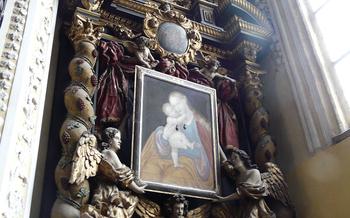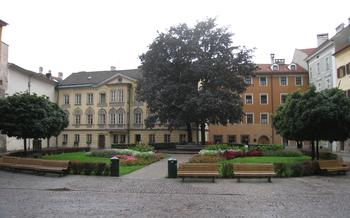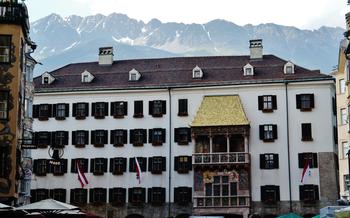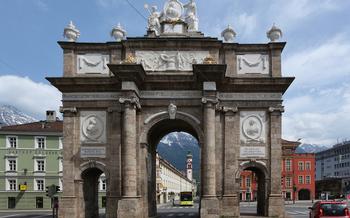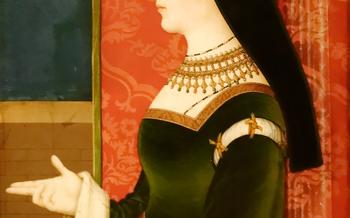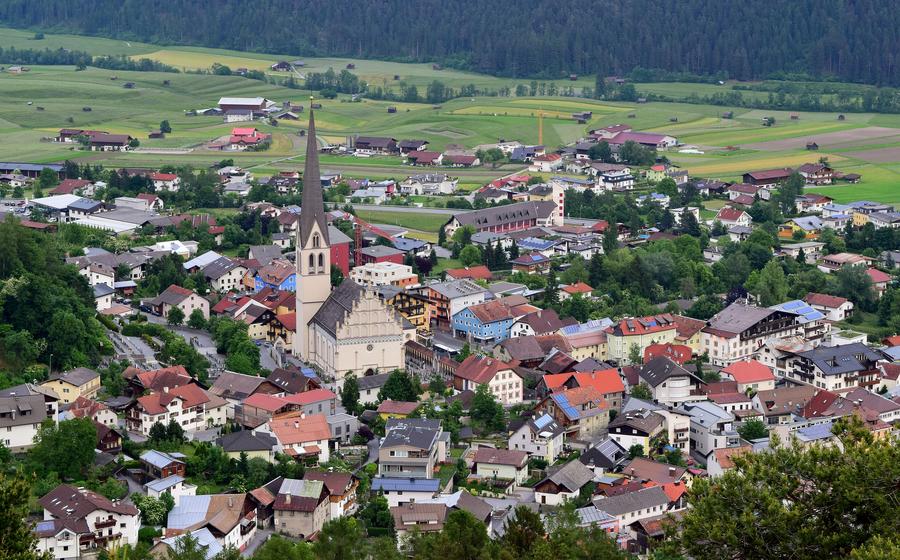
Hofburg Imperial Palace, Innsbruck
- Hofburg Imperial Palace, Innsbruck: A Majestic Legacy
- Exploring the Imperial Apartments: Glimpses of Habsburg Life
- The Giant Hall: A Symbol of Imperial Power
- The Imperial Chapel: A Sacred Space
- The Silver Chapel: A Treasury of Precious Artifacts
- The Hofburg Congress Center: A Modern Venue
- The Hofburg Innsbruck Card: A Valuable Pass
- Photography and Videography: Capturing Memories
- Souvenirs and Gifts: Mementos of Your Visit
- Dining Options: Savoring Culinary Delights
- Nearby Attractions: Exploring Innsbruck
- Insider Tip: Unveiling a Hidden Gem
Hofburg Imperial Palace, Innsbruck: A Majestic Legacy
The Hofburg Imperial Palace in Innsbruck stands as a testament to the grandeur and rich history of the Habsburg dynasty. Its construction, dating back to the 15th century, marked the beginning of a grand era for the city of Innsbruck. The palace's architectural style, a blend of Gothic and Renaissance elements, showcases the transition from medieval to modern times.
Once the residence of the Tyrolean branch of the Habsburg family, the Hofburg served as the political and administrative center of Tyrol for centuries. Within its walls, emperors and empresses held court, made decisions that shaped the course of history, and hosted lavish events that attracted nobility from across Europe. The palace's cultural significance is undeniable, as it was a hub for the arts, with renowned musicians, artists, and scholars being welcomed as guests.
As you step through the gates of the Hofburg Imperial Palace, you will be captivated by its grandeur and beauty. The intricate carvings, opulent decorations, and stunning frescoes that adorn its walls and ceilings tell stories of a bygone era. Each room holds secrets and whispers of the past, waiting to be discovered.
Exploring the Imperial Apartments: Glimpses of Habsburg Life
The Imperial Apartments within the Hofburg Imperial Palace offer a fascinating glimpse into the private lives of the Habsburg emperors and empresses who once called this magnificent palace home. These grand living quarters, steeped in history and opulence, were not merely ceremonial spaces but served as the heart of the Habsburg family's domestic life.
Each room within the Imperial Apartments tells a story of the Habsburg dynasty's grandeur and the daily routines of its illustrious occupants. Visitors can admire the exquisite artwork, furniture, and decorations that adorn these opulent chambers, providing a glimpse into the tastes and preferences of the Habsburg rulers.
One of the most striking features of the Imperial Apartments is the bedroom of Emperor Franz Joseph I and Empress Elisabeth, known as "Sisi." This room, with its rich colors and intricate tapestries, offers a glimpse into the private life of the beloved imperial couple. Visitors can imagine the intimate moments shared between Franz Joseph and Sisi within these walls, far from the public eye.
The Imperial Apartments also house a number of other significant rooms, including the dining room, the library, and the music room. Each room is unique in its design and furnishings, reflecting the individual tastes and interests of the Habsburg family members who occupied it.
A visit to the Imperial Apartments is a journey through time, allowing visitors to step back into the world of the Habsburgs and experience the grandeur and opulence of their everyday lives.
The Giant Hall: A Symbol of Imperial Power
The Giant Hall, also known as the Riesensaal, is the largest and most impressive room in the Hofburg Imperial Palace. It is a magnificent example of Renaissance architecture and a testament to the power and grandeur of the Habsburg dynasty. The hall is 56 meters long, 17 meters wide, and 12 meters high, and can accommodate up to 5,000 people.
The hall was built in the 16th century by Emperor Ferdinand I as a ballroom and banquet hall. It was used for many important historical events, including the coronation of Holy Roman Emperors, state banquets, and other grand celebrations. The hall was also used for religious ceremonies, such as the celebration of Mass.
The Giant Hall is decorated with exquisite frescoes, sculptures, and tapestries. The ceiling is adorned with a fresco depicting the Habsburg family tree, while the walls are lined with tapestries depicting scenes from Austrian history. The hall also features a magnificent chandelier made of crystal and bronze.
The Giant Hall is a symbol of the imperial power and grandeur of the Habsburg dynasty. It is a must-see for anyone visiting the Hofburg Imperial Palace.
The Imperial Chapel: A Sacred Space
Nestled within the walls of the Hofburg Imperial Palace, the Imperial Chapel stands as a testament to the deep religious devotion of the Habsburg dynasty. Its stunning architecture, featuring intricate carvings, magnificent stained glass windows, and soaring ceilings, creates an atmosphere of awe and reverence.
The chapel holds immense religious significance for the Habsburgs, serving as their private place of worship. Here, they would gather for mass, pray for guidance, and seek solace in their faith. The chapel's sacred ambiance and rich history evoke a sense of spirituality and tranquility, inviting visitors to pause and reflect on the deep-rooted religious traditions of the Habsburg family.
Throughout history, the Imperial Chapel has witnessed countless religious ceremonies, including weddings, baptisms, and coronations. These grand events were testaments to the Habsburgs' faith and their close relationship with the Catholic Church. The chapel's walls hold secrets and stories of imperial devotion, whispered prayers, and moments of deep spiritual connection.
One particularly poignant anecdote is that of Emperor Maximilian I, who commissioned the construction of the chapel. A devout Catholic, Maximilian frequently retreated to the chapel to pray and seek guidance. It is said that he would often kneel before the altar, lost in contemplation and communion with his faith.
Whether you are a history buff, a lover of architecture, or simply seeking a moment of peace and reflection, the Imperial Chapel is an essential destination within the Hofburg Imperial Palace. Its sacred ambiance and rich history invite visitors to connect with the spiritual side of the Habsburg dynasty and experience the profound religious traditions that shaped their lives.
The Silver Chapel: A Treasury of Precious Artifacts
Nestled within the walls of the Hofburg Imperial Palace, the Silver Chapel stands as a testament to the opulence and extravagance of the Habsburg dynasty. Steeped in historical significance, the chapel served as a sacred space for the Habsburg family, where they worshipped and displayed their collection of precious artifacts.
As you step into the chapel, you are immediately struck by its stunning architecture. Intricate carvings adorn the walls, while magnificent stained glass windows bathe the interior in a soft, ethereal light. The focal point of the chapel is its exquisite altar, which is adorned with an array of silver ornaments, candlesticks, and crucifixes.
The chapel's collection of silver artifacts is truly awe-inspiring. Goblets, plates, and other items, all crafted from the finest silver, are displayed in intricate patterns that showcase the exceptional craftsmanship of the Habsburg era. Each piece tells a story of opulence and power, reflecting the Habsburgs' wealth and influence.
One of the most remarkable pieces in the collection is the Silver Madonna, a statue of the Virgin Mary that is adorned with over 3,000 precious stones. This exquisite work of art is a testament to the Habsburgs' devotion to their faith and their patronage of the arts.
A visit to the Silver Chapel is a journey through time, allowing visitors to glimpse the lavish lifestyle and religious devotion of the Habsburg dynasty. The chapel's collection of silver artifacts is a testament to the power and influence of the Habsburgs, and it offers a unique insight into their world.
The Hofburg Congress Center: A Modern Venue
The Hofburg Imperial Palace is not only a historical landmark but also a modern venue for prestigious events and conferences. The Hofburg Congress Center, located within the palace complex, offers state-of-the-art conference facilities and event spaces that cater to a wide range of gatherings.
The Congress Center boasts striking modern architecture, blending seamlessly with the historical charm of the palace. Its spacious conference rooms, equipped with cutting-edge audiovisual technology, can accommodate events of various sizes, from intimate meetings to large-scale conferences.
The Hofburg Congress Center has hosted numerous international events, including summits, forums, and exhibitions. Its reputation for excellence and its unique setting make it a sought-after venue for organizations and institutions worldwide.
Anecdote:
During a conference held at the Hofburg Congress Center, I had the opportunity to witness firsthand the exceptional service and attention to detail provided by the staff. Despite the large number of attendees, the event ran smoothly, and every participant's needs were met promptly and efficiently. The seamless coordination and professionalism of the staff left a lasting impression on me and all the attendees.
The Hofburg Innsbruck Card: A Valuable Pass
The Hofburg Innsbruck Card offers visitors a convenient and cost-effective way to explore the Hofburg Imperial Palace and its many attractions. The card provides free admission to the palace's museums, including the Imperial Apartments, the Giant Hall, the Imperial Chapel, the Silver Chapel, and the Hofburg Museum. Additionally, cardholders receive discounts on guided tours, concerts, and special events held at the palace.
Participating attractions include the Hofburg Imperial Palace, the Imperial Gardens, the Hofburg Congress Center, the Hofburg Museum, and the Silver Chapel. The card is available in two options: a one-day pass and a three-day pass. The one-day pass costs €25 for adults and €50 for children, while the three-day pass costs €35 for adults and €150 for children.
To make the most of your Hofburg Innsbruck Card, plan your visit in advance and identify the attractions you want to see. The card is valid for one year from the date of purchase, so you can use it on multiple visits to the palace. Remember to bring your card with you when you visit the palace, as you will need to show it to gain admission to the museums and attractions.
Photography and Videography: Capturing Memories
Photography enthusiasts and videographers will delight in the opportunity to capture the grandeur and beauty of the Hofburg Imperial Palace through their lenses. While photography and videography are generally permitted within the palace, it is essential to adhere to certain guidelines and regulations. Flash photography and tripods are not allowed in some areas to preserve the integrity of the exhibits and artwork.
To make the most of your photographic journey, explore the palace's many captivating spots, such as the Giant Hall with its soaring arches and intricate ceiling frescoes, the Imperial Chapel with its stunning stained glass windows, and the Silver Chapel showcasing its exquisite collection of silverware. Experiment with different angles and lighting conditions to capture the essence of each room and artifact.
Share your photographic and videographic creations with the world, using the #HofburgImperialPalace hashtag on social media. Inspire others with your unique perspectives and contribute to the visual tapestry of this magnificent palace.
Souvenirs and Gifts: Mementos of Your Visit
The Hofburg gift shop is a treasure trove of unique souvenirs and gifts that will serve as lasting mementos of your visit to the Hofburg Imperial Palace. From traditional Austrian handicrafts to exclusive palace-themed items, there's something for everyone.
Browse through the shelves and you'll find an array of handcrafted items, such as intricate wooden carvings, colorful ceramics, and delicate glass ornaments. These pieces showcase the skill and artistry of local artisans and make for wonderful gifts for friends and family back home.
For those who prefer something more exclusive, the gift shop offers a range of palace-themed souvenirs. These include replicas of the imperial crown, miniature models of the palace, and elegant jewelry inspired by the Habsburg dynasty. These items are perfect for history buffs and collectors.
Prices at the Hofburg gift shop vary depending on the item, but there's something to suit every budget. You can find small trinkets for a few euros, or splurge on a more extravagant souvenir to commemorate your visit.
Before you leave, make sure to pick up a postcard or two featuring stunning images of the palace. These make for a great way to send a piece of Innsbruck back home to loved ones.
Dining Options: Savoring Culinary Delights
Within the Hofburg complex, visitors can find a variety of dining options to satisfy their culinary cravings. The Hofburg Restaurant, located in the heart of the palace, offers a refined dining experience with a menu that showcases traditional Austrian cuisine with a modern twist. For a more casual dining experience, the Hofburg Café is a great choice, serving delicious pastries, sandwiches, and coffee in a relaxed atmosphere.
For those seeking a taste of traditional Tyrolean cuisine, the Tiroler Stuben restaurant is a must-visit. This cozy restaurant offers a warm and inviting ambiance, along with a menu featuring hearty dishes such as schnitzel, dumplings, and Tyrolean specialties.
If you're looking for international culinary experiences, the Hofburg also houses several restaurants that offer a diverse range of cuisines. From Italian and French to Asian and American, there's something to satisfy every palate.
Anecdote:
During my visit to the Hofburg, I had the pleasure of dining at the Tiroler Stuben restaurant. The atmosphere was warm and welcoming, and the staff were incredibly friendly and attentive. I highly recommend the Tiroler Gröstl, a traditional dish made with potatoes, meat, and onions. It was absolutely delicious and left me feeling satisfied and content.
Nearby Attractions: Exploring Innsbruck
Venturing beyond the Hofburg Imperial Palace, Innsbruck offers a wealth of additional attractions that beckon with their unique charms. One such gem is the Golden Roof, an iconic landmark renowned for its intricate golden tiles that shimmer in the sunlight. This architectural masterpiece, dating back to the 15th century, once served as the residence of Emperor Maximilian I and is now a symbol of Innsbruck's rich history.
Another must-visit attraction is Ambras Castle, a magnificent Renaissance-era castle perched atop a hill overlooking the city. Step into a world of history and splendor as you explore its grand halls, admire its impressive collection of armor and weapons, and soak in the breathtaking views of Innsbruck and the surrounding mountains.
For a leisurely stroll, head to Maria Theresien Straße, a vibrant pedestrian zone lined with elegant historical buildings, charming boutiques, and inviting cafes. Admire the stunning architecture, do some shopping, or simply relax and soak in the lively atmosphere.
Innsbruck offers an array of experiences beyond these iconic landmarks. Immerse yourself in art at the Tiroler Landesmuseum Ferdinandeum, discover the wonders of science at the Audioversum Science Center, or take a scenic hike or bike ride through the picturesque Nordkette Mountains. The city's vibrant nightlife, with its many bars and clubs, ensures that there's something for everyone to enjoy.
Insider Tip: Unveiling a Hidden Gem
Beyond the grand halls and opulent chambers of the Hofburg Imperial Palace lies a hidden gem, a secret passage that whispers tales of intrigue and forgotten history. This concealed corridor, once known only to a select few, offers a glimpse into the palace's intriguing past.
The secret passage, believed to date back to the 16th century, was constructed as a means of discreet movement for the Habsburg rulers and their trusted entourage. It allowed them to navigate the vast palace complex without being seen by the public or court officials.
To access this hidden gem, visitors must venture into the depths of the palace, seeking out a seemingly inconspicuous door. Once opened, the door reveals a narrow and dimly lit staircase that leads to the passage.
As you descend the stairs, a sense of mystery and anticipation builds. The air is heavy with the weight of history, as if the walls themselves hold secrets waiting to be uncovered.
Emerging from the staircase, you find yourself in a long and narrow corridor, its walls adorned with faded tapestries and flickering torches. The passage winds its way through the palace, connecting different chambers and offering a unique perspective on the palace's hidden corners.
It is easy to imagine the Habsburg rulers and their trusted advisors traversing this secret passage, their footsteps echoing through the centuries. Perhaps they were engaged in clandestine meetings, planning strategies, or simply seeking a moment of solitude away from the watchful eyes of the court.
The secret passage is a testament to the rich history and intrigue that lies beneath the surface of the Hofburg Imperial Palace. It invites visitors to step back in time and experience the palace from a new and unexpected perspective.

